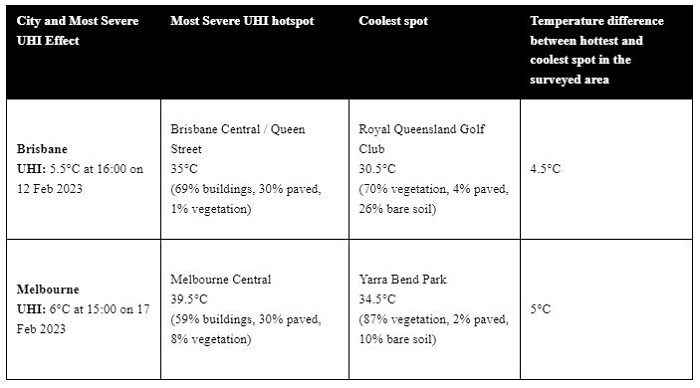UHeat, a digital tool developed by sustainable development consultancy, Arup, has been used to analyse the urban heat island (UHI) effect on major cities around the world in a new international survey.
Employing AI and satellite images, the tool can identify locations where urban forms are intensifying heat and then rapidly model solutions that will help cities reduce the impact of hot spots.
The tool analysed the city centres of Melbourne and Brisbane on their hottest days in 2023, and found that Melbourne Central and Brisbane’s Queen Street were up to 6°C hotter than they would be in an undeveloped setting.

Following an analysis of a diverse range of global cities including Singapore, Cairo, London, Los Angeles, Madrid, Mumbai and New York, Arup’s Urban Heat Snapshot reveals that in the majority of cities, the hottest spots had less than 6% vegetation cover, while the coolest spots had over 70% cover, mostly in parks. The Melbourne and Brisbane results were in line with these findings, showing leafy parklands with large percentages of permeable surface areas as least affected by the UHI effect.
Arup’s global resilience and adaptation lead, Dr Kaitlin Shilling hopes urban planners and designers will take up the tool to mitigate the urban heat effect and improve the lived experience for the millions of Australians living in major cities.
“If we keep resilience front of mind in the design process, we can create neighbourhoods that are cool, both in terms of temperature and urban amenity. We need to think beyond just green spaces and trees to keep temperatures down, and consider how to capture breezes, increase shade and incorporate materials that are cooler. The benefits of these designs expand beyond minimising heat – they can improve the vibrancy of urban streets, enhance health and wellbeing by encouraging walkability, and also have secondary resilience benefits by acting as flood mitigations.” says Dr Shilling.
The rising heat in cities is attributed to climate change, with the number of cities exposed to extreme temperatures, 35°C and above, expected to triple by 2050[1]. In Australia, major heatwaves have caused more deaths since 1890 than bushfires, cyclones, earthquakes, floods and severe storms combined. Also, it is increasingly understood that around the world, less socio-economically advantaged neighbourhoods are more at risk to heat exposure, due to factors such as a lack of trees and air-conditioning[2].
As Australian cities grapple with growing populations and a national housing crisis, Arup cities leader, Australasia, Malcolm Smith underlines the importance of designing for cool.
“Designing cities that are sustainable, inclusive, and equitable means addressing key issues that impact on the health and wellbeing of the people that live, work, and play in these spaces. Planning and development processes urgently need to prioritise and emphasise environmental efficiencies, such as insulation, and wind corridors,” says Smith.
“I’m a big fan of improving tree canopies. Trees planted decades ago can grow into iconic markers for neighbourhoods. But a mature tree canopy takes years to grow. We know that 80-90% of the cities that will exist in 10 years are made up of what we’ve already built, so mitigation and retrofits have to be part of the equation,” he adds.
Key solutions suggested in Arup’s Urban Heat Snapshot report:
Increasing tree canopy: Trees are proven to lower temperatures in cities and reduce heat-related mortality. A recent study of European cities in The Lancet reveals how increasing city tree coverage to 30% could have prevented 2644 excess deaths[3].
Creating more permeable surfaces: Permeable surfaces, such as bare or planted soil, tend to absorb less heat compared to impermeable surfaces like concrete or asphalt. Increasing permeable surfaces and allowing water to infiltrate into the ground will reduce temperatures and cool the surrounding environment.
Using every space possible: More than half of the space in cities (including roofs and streets) are open. By greening building facades and roofs or using white paint to change the reflectiveness of surfaces and reduce the amount of heat absorbed from the sun, temperatures can be brought down.
Establishing cool islands: With cities set for heatwave conditions every summer we need to create a network of cooling spaces in cities for people to take refuge. For example, in London, Arup worked with the Greater London Authority to map cool spaces – where locals could find shelter during hot days.
Sparking behaviour change: People will also need to change the way they live in cities within the next decade. Hot countries around the world have been adjusting their lives to this for centuries, and it’s time to learn from them – incorporate siestas, reconsider office hours, and close shops and restaurants during peak heat.
Download the Urban Heat Snapshot.
Image: https://www.climatecouncil.org.au/urban-heat-island-effect-western-sydney/
References:
[1] Around 200 million city-dwellers in over 350 cities live with summer temperature highs of over 35 degrees Celsius. The number of cities exposed to extreme temperatures will triple by 2050. C40 Cities – Heat Extremes
[2] A study by Yale School of Forestry and Environmental Studies (T Chakraborty) of 25 cities around the world found that in most (72%) of the cases, poorer neighbourhoods experience elevated heat exposure due to factors such as lower vegetation density.
[3] Study published by The Lancet: Cooling cities through urban green infrastructure: a health impact assessment of European cities

